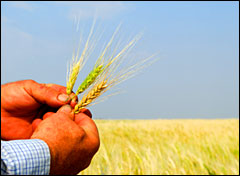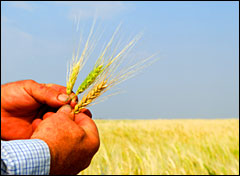When I think about what a truly healthy, vibrant food system would look like, I envision more farms: small farms serving specific communities, and diversified, midsized farms geared to supplying their surrounding regions.

Many hands make site work.
Of course, there would still be interstate and global trade — you can’t grow olives or coffee in Iowa, or enough wheat in Florida to supply the state’s bakers. But with more farms across the nation, we could all generally eat much closer to home, consuming fewer resources and throwing off less pollution in the process. Traveling would be more interesting as well. Imagine finding region-specific, seasonal specialties — not standardized burgers — at train stations across the land. (Oh yeah, in my vision, there’d also be a high-functioning national rail system.)
In some ways, this scenario — the food part, anyway — isn’t so far-fetched. I’ve watched people’s zeal to “eat local” rise dramatically over the past 10 years. And now, even the business media are taking it seriously. Just last week, BusinessWeek joined the chorus heralding the “Rise of the Locavore,” noting that, “Consumers increasingly are seeking out the flavors of fresh, vine-ripened foods grown on local farms rather than those trucked to supermarkets from faraway lands.” Nationwide, the number of farmers’ markets ballooned by 50 percent between 2001 and 2006, BusinessWeek reports.
But consumer demand alone can only create so much change. Though the locavore movement is heartening and necessary, it remains a tiny organism compared to our great lumbering beast of an industrial food system. By some estimates, local-oriented farms supply something like 2 percent of U.S. food calories. To move beyond the farmers’ market box, farms producing for local and regional markets will have to multiply in number far more than that impressive 50 percent figure.
I’ve already identified one major obstacle between my reverie and reality: infrastructure. As I wrote in a recent column on the need to revive the dismal fortunes of midsized farms, the infrastructure needed for such farms to thrive — locally owned grocery stores, dairy-processing plants, slaughterhouses, canneries — has withered away as the food industry consolidated over the decades.
In the weeks since that column, I’ve hit upon another roadblock: a growing labor shortage that’s falling particularly hard on midsized farms.
Belaboring the Point
At first glance, New York would seem a particularly ripe state for a midsized farm renaissance. It boasts a bustling metropolis — the nation’s largest — with a strong and growing locavore scene. Combined with population centers like Albany and Rochester, the vast organism that is greater New York City might be expected to provide a robust market for the midsized farms that dot the state’s landscape.
Yet those very farms are struggling to harvest their produce because of an ongoing labor shortage. And produce unharvested means produce unsold — and farms in trouble.
According to a recent New York Times piece, upstate farms are suffering because very few U.S.-born citizens will accept agriculture jobs — and the undocumented workers who have been staffing them for years are being hounded out by anti-immigration zeal.
As a result, farmers are scaling back production of labor-intensive fruit and vegetable crops and investing heavily in labor-replacing machinery. Substituting human labor with machinery not only boosts agriculture’s fossil fuel use, it also makes farms more vulnerable by strapping them with debt.
Not surprisingly, their lenders are getting nervous. In testimony last fall before the U.S. House Agriculture Committee, an official from Farm Credit of Western New York estimated that more than 800 farms in the state, representing 750,000 acres in farmland, were “highly vulnerable to going out of business or forced to [become] part-time farms from a severe labor shortage.”
These operations, whose average size is less than 100 acres, essentially represent New York’s base of midsized farms. The Farm Credit official predicted that if those farms fail, much of that land would likely remain in some form of agriculture, but that “hundreds of thousands of acres would be vulnerable to being discontinued from crop production and converted to non-farm uses.”
In other words, what’s left of New York’s most productive farmland may soon be sprouting second homes and vacation condos where it once produced tomatoes and green beans.
U.S. Farms Migrate to Mexico
The problem is by no means limited to the Northeast. In California, the Associated Press reports, Mexican farmworkers are having trouble heading north over an increasingly well-patrolled border — but U.S. farm owners are crossing the other way freely. According to AP, “Many [U.S. growers have] moved their fields to Mexico, where they can find qualified people, often with U.S. experience, who can’t be deported.”
When they jump the border to buy land — presumably without having to risk their lives in the desert or hire “coyotes” to ease the passage — U.S. farm owners find an oasis of cheap and compliant labor. AP reports that U.S. farm employers can buy a whole day’s worth of labor for a wage ($9.60) equal to an hour’s worth of work at the going rate north of the border — while still doubling Mexico’s minimum wage of $4.80 per day.
Now, the AP article is talking mainly about large-scale agriculture here — the kind that keeps your local Wal-Mart stocked with little bags of baby spinach and asparagus all year. In the logic of industrial farming — where food is grown in vast, centralized monocrops, and then distributed in thousand mile-plus radii — the shift from California to Mexico makes a certain sense. “Mexico is closer to eastern U.S. markets than California,” Associated Press reports. “Shipping times to Atlanta are a day shorter from Mexico’s central Guanajuato state.”
But the labor crunch is surely also squeezing California’s midsized operations — the farms that will be needed to broaden local-food access in one of the nation’s most economically stratified states. In farm fields larger than even a few acres, diversified vegetable farming is extremely labor intensive — and in the modern U.S., farm labor generally means immigrant labor.
What, then, is the answer? In the short term, the U.S. should end its ridiculous nativist immigration policies. As I’ve written before, Mexican farmworkers don’t sneak across one of the globe’s most militarized borders to freeload off of U.S. taxpayers, despite the fantasies of certain cable-TV commentators. Rather, they’re fleeing a near-complete meltdown in small-scale Mexican agriculture — one that directly implicates the free-trade zeal of U.S. policymakers and corporations.
But even if U.S. policymakers did open the border — highly unlikely — we can’t build a sustainable food system in the United States on the backs of former Mexican farmers who have been driven off their land by NAFTA and other binational U.S.-Mexico policies. The time has come for the U.S. sustainable-food movement to develop a North American consciousness — to foster a farmworker movement of its own, and to seek coalitions with Mexican small-farm advocates to rebuild local and regional food networks on both sides of the border.

Simultaneously, it’s time to develop an idea floated by Anna Lappé on Grist a couple of months back: farm work as a green-collar job. Heard of Teach for America, the federal program that draws college graduates into critically important, but horribly paid, public-school jobs? The time for Farm for America is ripe — as ripe as the fruit that will soon be rotting on vines across the country for lack of pickers.


